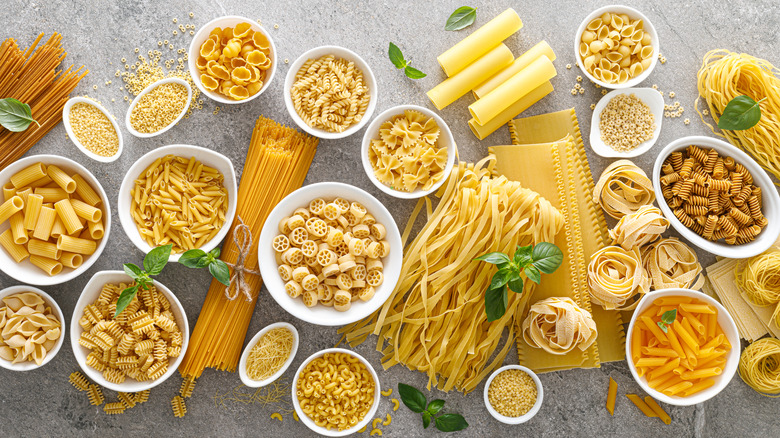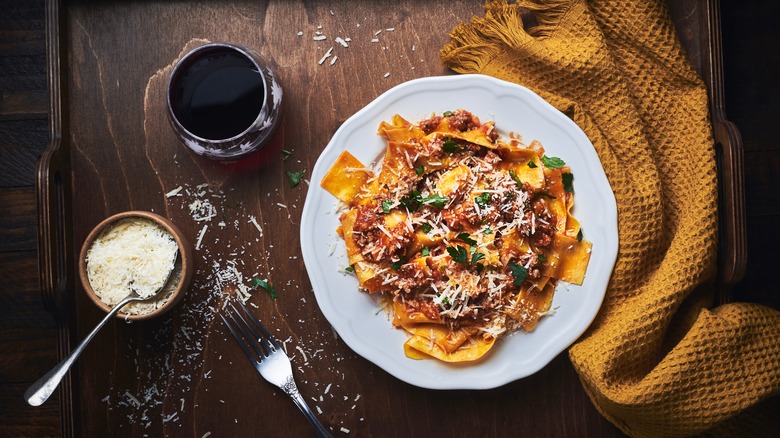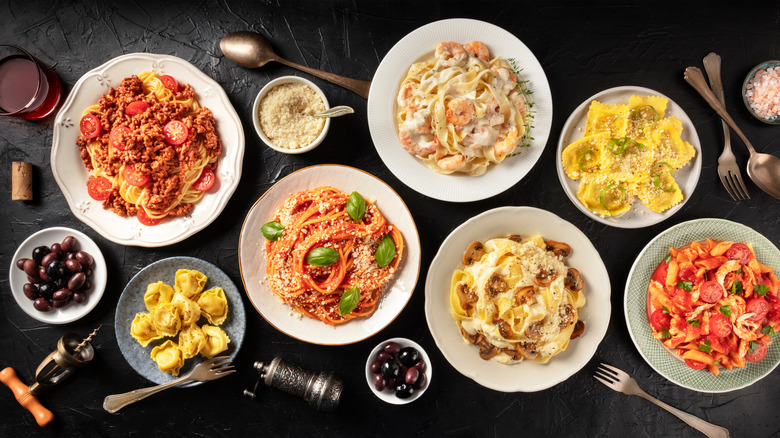How To Choose The Best Pasta Shape For Your Sauce
Over the centuries, Italian cuisine has grown to encompass a bewildering variety of pasta shapes and sizes, from tiny, seed-like tempestine to straw-shaped bucatini and chunky rigatoni, and hundreds more — roughly 350 varieties in total. These noodles can generally be grouped into four major categories — long, short, stuffed, and those intended for soup– but except for the latter designation, a pasta's shape doesn't really reveal what kind of dishes or sauces it should be paired with. Likewise, Italian cuisine boasts a rich array of pasta sauces, adding to the overwhelming nature of it all.
To understand how pasta shapes and sauces relate to each other, we consulted Vincent Benoliel, whose Pasta Corner restaurants in Los Angeles and New York City are renowned for their freshly-made pastas and sauces. According to Benoliel, it's the sauce that determines which pasta you should use, and not the other way around. Still, a good pairing elevates both elements. "You always want a good balance of pasta and sauce so you can taste both components," he points out, as "more delicate pastas can be overwhelmed by heavier sauces."
The art of pasta and sauce pairing
Like pastas, Italian sauces can be grouped according to category, with creamy, tomato-based, and meat sauces being the primary three styles. For the former, Vincent Benoliel advocates for a so-called "snail-shaped" pasta called lumache. This noodle has a shell-like shape with a pocket inside that is perfect for holding a creamy sauce. Benoliel's Pasta Corner restaurants pair lumache with their signature creamy pink vodka sauce.
For tomato-based sauces, Benoliel is partial to pasta rigati, named for the ridges that line the tubular-shaped noodles. He explains that the ridges "give the tomato sauce something to stick to and help infuse pasta with the sauce." Beyond rigati, rigatoni is also named for its ridged sides, and ridged penne, ziti, and similar noodles pair just as well with tomato-based marinara or spicy arrabiata sauces.
Meat sauces are a bit more complicated in terms of pairings, as according to Benoliel, "It depends on how thick and hearty the sauce is." Spaghetti with Bolognese, for example, is a classic pairing, but this famously long, thin pasta isn't necessarily well-suited to some of heartier meat sauces. Benoliel believes that especially thick and rich meat sauces require wider pastas as ideal pairing partners. He prefers wide and thick pappardelle, for instance, with a substantial beef ragù.
Some pasta shapes are more all-purpose
Some pasta types are versatile enough to be matched with many different sauces. "Spaghetti, for example, is one of the most versatile," Vincent Benoliel notes. "It can be paired with a wide range of sauces from light ones like cacio e pepe (pecorino romano cheese and black pepper), aglio e olio (garlic and olive oil), vongole (clams), to tomato and a bit richer carbonara to even some meat sauces." However, he encourages home cooks to branch out beyond using only all-purpose noodles, as "it's more fun to try different pasta shapes with different sauces".
At Pasta Corner, pappardelle with beef ragù and spaghetti Bolognese are on the menu, adhering to Benoliel's recommendations, but he (and co-owner Matt Pokora) also serve long, ribbony tagliatelle with Alfredo sauce, rather than sticking to smaller shapes for the creamy sauce. Home cooks ought to try pairing their favorite sauces and pastas together — adhering to basic advice, like minding the heaviness of the sauce — and see what sticks for them. With hundreds of pasta shapes available on the market, there's plenty of room for experimentation in your own kitchen.



